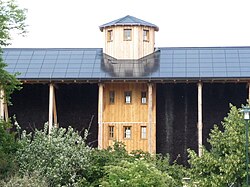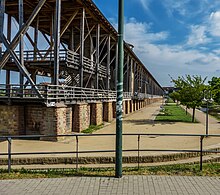Graduation tower (Bad Dürkheim)
| Graduation tower | ||
|---|---|---|
 Graduation tower in 2011 |
||
| Data | ||
| place | Bad Dürkheim | |
| architect | Albert Schenk | |
| Architectural style | open wooden construction on sandstone pillars, open roof truss | |
| Construction year | 1846-1847 | |
| height | 18 m | |
| Coordinates | 49 ° 27 '56 " N , 8 ° 10' 29" E | |
|
|
||
| particularities | ||
| Arson in 1992 and 2007 | ||
The Bad Dürkheimer graduation , locally often only " graduation ", "Gradierbau" or " Saline called," is a part of the treatment plant the county town of Bad Durkheim in Rhineland-Palatinate . The system increases the salt content of a brine through so-called grading ; When they evaporate, the salt content of the ambient air also increases, so that outdoor inhalation for therapeutic purposes is possible.
The graduation tower is one of the landmarks of the Palatinate spa and district town, which is also the sponsor . In its current form it was built between 1847 and 1850 and with a length of 333 m it is one of the largest in Germany. After being destroyed twice by arson in 1992 and 2007, it was restored and last reopened in 2010.
Geographical location
The graduation tower extends to 114 m above sea level. NHN in the northern area of the city between the North Wine Route and the Salinenstrasse from north-northwest to south-southeast. It closes the Brühlwiesen , where the Dürkheim sausage market has been held since 1577 , and the Kurpark to the east. The southern half of the graduation tower borders the Park Clinic to the east .
investment
In the 333 m long and up to 18 m high system, around 250,000 bundles of brushwood are layered to form walls; Salt water from a healing spring trickles over these brushwood walls , from which up to 25 m³ evaporate on hot days. The salt-containing droplets are said to have a positive influence on the lungs and bronchi , and the surrounding air is also cooled by evaporation.
history
Former graduation towers
Salt springs in Bad Dürkheim are documented from 1387. In 1594, the first saltworks, the Schönfelder Salzhütte , was built in the east of the city on the site of the Schönfeld Benedictine convent , which was dissolved in 1571 . However, due to the Thirty Years' War , among other things , it was abandoned in the 17th century. In 1716 the site was sold to the Alsatian Georg Jakob Duppert, who repaired the salt works and operated it under the name "Duppert'sches Gradierwerk" . In 1736 ownership passed to the Electoral Palatinate , and the salt works were named "Philippshall" after Elector Karl Philipp . A more efficient supply of the system was now ensured: the water from the Isenach flowing through the city was used to operate the pumps ; The Floßbach was specially dug as a connection between Rehbach and Isenach to transport the required wood, which came from the Neustadter Valley by means of drifting on Speyerbach and Rehbach . For many years, Johann Michael Pfeiffer († 1803), father of Franz Joseph Pfeiffer (1772–1847), who grew up there and succeeded in office and who in turn was the grandfather of the future American railroad magnate Henry Villard, was the manager of the salt works .
In the period that followed, five more graduation towers were built in Bad Dürkheim that used the salt from Dürkheim's Philippshall salt works . Thanks to the newly introduced technique of thorn graduation, this produced 6600 Malter Salt annually. Dürkheim salt became particularly popular in the second half of the 18th century.
The six graduation towers that finally existed in Bad Dürkheim were as follows:
- The Churpfaltz graduation house built by Joachim Friedrich von Beust with a length of 2506 feet and 10 inches, i.e. about 731 m.
- The Zweybrücken graduation house along today's Dr.-Kaufmann-Strasse with a length of 1220 feet and 10 inches, i.e. about 356 m.
- The Sulzbach graduation house with a length of 1181 feet, i.e. about 345 m, which was also known as "shingle building" because of its roof covering with wooden shingles.
- The Churbayern graduation house on today's Große Allee with a length of 1160 feet, i.e. about 339 m.
- The oldest Duppert graduation tower, established as such in 1716, in a north-south direction, ending in the north at the sawmill, with a length of 922 feet and 9 inches, i.e. about 269 m.
- A small graduation tower near Duppert's graduation tower in an east-west direction, with a length of 240 feet, i.e. about 70 m.
In 1792 several graduation towers were affected by a hurricane . In 1794, during the French era , the previous building of today's graduation tower was plundered by French troops and declared state property. Since the system was then not maintained, it threw no more profit and fell into disrepair again. In 1816 it came under the administration of the Kingdom of Bavaria with the entire Palatinate on the left bank of the Rhine .
Preserved graduation tower
From 1847 to 1850 the saltworks was renovated and the saltworks director Albert Schenk built the only preserved graduation house in the city on the site of the former Zweybrücken graduation house. In 1868 the facility came from the property of the Kingdom of Bavaria to the city of Bad Dürkheim. In 1913 the salt production, which had been operated by the specially founded bathing and saltworks association since 1872 , was discontinued because it had proven to be no longer economical. From then on, the graduation tower was only used for breathing therapy through the salt aerosols released into the air .
Originally the building was equipped with various observation towers, balconies, dormers and walkways. As their maintenance became too expensive, the graduation tower was continually dismantled. When the roof was renewed at the beginning of the 20th century, all such structures and extensions were removed.
After the facility was badly damaged by bombs in World War II , the spa business was resumed in the 1950s.
Between 1859 and 1960 the graduation tower was operated with the salty water of the Alte Maxquelle , which also had the highest arsenic content in Germany. In 1984 the graduation tower was placed under monument protection.
Arson and redevelopment
After a fire on July 1, 1992, an approximately 80 m long section of the graduation tower burned down. The reconstruction was accompanied by a thorough renovation in which an attempt was made to restore the original state including the turrets and balconies using historical templates. In 1997 the facility was able to be reopened.
Ten years later, on April 7, 2007, another fire was started. This time the system was on fire over its entire length of over 300 m. Since the irrigation of the brushwood bundles had already resumed after the winter break, a large part of the bundles survived the fire unscathed; However, the entire roof structure, constructed from wooden beams, burned out, which led to dilapidation. The fire brigade estimated the amount of damage to be 10 million euros. The four young men identified as perpetrators were sentenced to several years in prison; the early release of two was rejected by the court in the summer of 2010 because "the necessary favorable prognosis" could not yet be made.
On August 6, 2007, the demolition of the dilapidated parts began in order to secure the ruins and to be able to lift the several months of closure of the site. Reconstruction of the building began on December 2, 2009. The roof of the new building was fitted with a photovoltaic system , and warm spring water is used for heating. The restart, originally intended for the sausage market in September 2010, was delayed by one month until October 9, 2010.
Web links
- Location and geographic data of the graduation tower on: Map service of the landscape information system of the Rhineland-Palatinate nature conservation administration (LANIS map) ( notes )
- Graduation building , City of Bad Dürkheim
- Salinarium and Saline , in: Pfalzlexikon
Individual evidence
- ↑ a b graduation building. City of Bad Dürkheim, accessed on October 3, 2015 .
- ↑ Location and geographic data of the graduation tower. LANDIS map, accessed on October 4, 2015 (query by clicking on “xyz” and the red cross).
- ^ The salt works in Bad Dürkheim burned down. t-online.de, April 7, 2007, accessed October 3, 2015 .
- ^ The Rhine Palatinate on Sunday . Ludwigshafen February 11, 2007.
- ↑ a b Pfalzlexikon S - Keywords: Salinarium and Saline. pfalzlexikon.de, archived from the original on October 26, 2013 ; accessed on May 1, 2019 .
- ↑ The Rhine Palatinate . Ludwigshafen June 20, 2007.
- ↑ The Rhine Palatinate . Ludwigshafen April 8, 2007.
- ↑ Salt pan fire: perpetrators remain in custody . In: Die Rheinpfalz , complete edition of the Südwestdeutsche Zeitung . Ludwigshafen August 24, 2010.
- ↑ The Rhine Palatinate . Ludwigshafen August 7, 2007.
- ↑ Graduation building will be inaugurated on October 9th . In: Die Rheinpfalz , local edition Bad Dürkheimer Zeitung . Ludwigshafen August 3, 2010.




